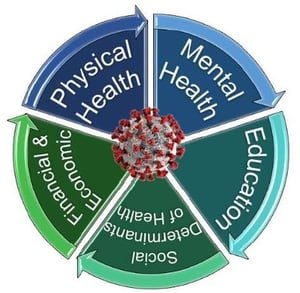- The mortality rate of known infections has declined from 2.9% in May to 0.5% through September
- Hospitalization rates and lengths of stay have declined as well (although there has been an uptick in the last week)
- COVID-19 does not appear to be a serious health risk to most residents under the age of 60; those between ages 80 and 89 now see an 80% chance of surviving. Even the most vulnerable population - those 90 years of age or older - are twice as likely not to be hospitalized or die.
While the clinical outcomes for COVID-19 have significantly improved, we continue to deal with the consequences of the nationwide shutdowns and impacts of social isolation. Below are five categories which were impacted by the pandemic.
Physical Health
- Vaccinations: Between mid-March and mid-April, childhood vaccinations declined substantially – there was a 2.5 million drop in regular (non-influenza) vaccinations in addition to a 250,000 drop in measles vaccinations1
- Preventive Screenings: There was a 60% decline in breast, cervical and colon cancer preventive exams nationwide
between mid-March and June 20202 - Stroke Evaluations: 40% of acute stroke victims chose not to seek emergency evaluation during the lockdown period3
- Cancer Care: The American Cancer Society reported that 79% of patients who were in active cancer treatments during COVID-19 saw a delay in treatment. Of these, one fifth feared that their cancer would grow or return as a result.4
Mental Health
- Homicides, Suicides and Overdoses: According to the Milwaukee County Medical Examiner, the county is on track for
setting all-time records in homicides, suicides and overdoses. At the current pace, overdose deaths will surpass COVID-19 deaths this year.5 - Workplace Morale: A recent poll by the National Alliance of Healthcare Purchasers Coalition indicates more than 83% of workers are experiencing mental health issues and 40% felt unsupported by their employers.6
- Anxiety and Depression: The CDC reports substantially elevated levels of mental health conditions. Year-to-year
comparisons for the second quarter show the prevalence of anxiety increased from 8.1% to 25.5%, while depressive
disorders increased from 6.5% to 24.3% and suicidal ideation increased from 4.3% to 10.7%.7
Education
- Virtual Learning: Distance learning is raising concerns of effectiveness and engagement. According to a report by the
Northwest Evaluation Administration, reading ability is estimated to drop by 30% and math skills by 50%. Socialization skills and physical fitness will also be impacted. The quality of education can be exacerbated by the economic and digital divides for school children that lack reliable computers and internet connections. Low-income children will likely be hurt the most by school closures.8 - Social Disruption: According to a report from Cook Children’s Medical Center in Fort Worth, delayed return to school
and return to normal life is leaving some children with a sense of hopelessness. The hospital said juvenile
attempted suicide patients were admitted at a rate of nearly one per day during August, which is more than double the number that were admitted during the same period five years ago.9
Social Determinants of Health
- Lifestyle and Ethnic Impacts: According to a study published in the Lancet, several social determinants of health will have a considerable impact on COVID-19 outcomes. Transmission is higher among the homeless, smokers were more likely to have a severe response than non-smokers, and infection rates were three times higher in predominantly black counties.10 In Wisconsin, blacks are dying at a rate that is more than 2.5 times their share of the population. Nationwide, blacks, Latinos and Native Americans are experiencing hospitalization rates 4.5 to 5.5 times higher than non-Hispanic whites.11
Financial & Economic
- Jobless Rate: In Wisconsin, unemployment rates have been steadily dropping from a high of 14.1% in April to 6.2% in
August. The US unemployment rate in August was 8.4%.12 - Below are a few of the facts about COVID-19 and the US Economy noted by the Brookings Institution:13
- Small business revenue dropped 20% between January and August
- New business formations fell off in spring, but are on track to outpace recent years
- In April 2020, the U.S. personal savings rate reached the highest level ever recorded
- Low-income families with children were most likely to experience an income shock
- From 2018 to mid-2020, the rate of food insecurity doubled for households with children
1. https://www.statnews.com/2020/05/08/childhood-vaccinations-decline-coronavirus-pandemic/
3. https://www.nejm.org/doi/full/10.1056/NEJMc2014816?query=featured_coronavirus
5. Milwaukee Medical Examiner Tweets posts between mid-August and late September 2020
6. https://www.ajmc.com/view/is-a-mental-health-crisis-emerging-in-the-us-workforce
7. https://www.cdc.gov/mmwr/volumes/69/wr/mm6932a1.htm
9. https://dfw.cbslocal.com/2020/09/24/cook-childrens-alarming-rise-suicide-patients/
10. https://www.thelancet.com/journals/lanres/article/PIIS2213-2600(20)30234-4/fulltext
13. https://www.brookings.edu/research/ten-facts-about-covid-19-and-the-u-s-economy/
COMMENTS